It's sad to read that Erika Remberg passed away last week, on 10 November 2017. Long ago we saw the beautiful Austrian film actress in the tearjerker Laila/Make Way for Lila (Rolf Husberg, 1958), as a foundling who is adopted and raised by a Lapland chieftain. Remberg appeared in 31 films between 1950 and 1970, but we want to remember her as lovely Laila.
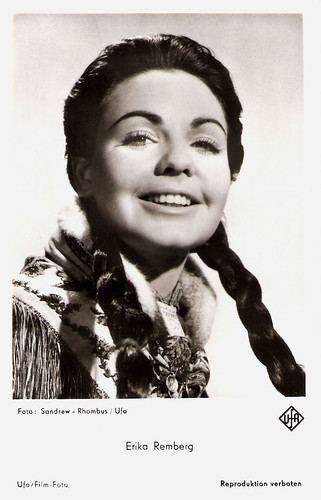
German postcard by Ufa, Berlin-Tempelhof, no. FK 4340. Photo: Sandrew / Rhombus / Ufa. Publicity still for Laila/Make Way for Lila (Rolf Husberg, 1958).
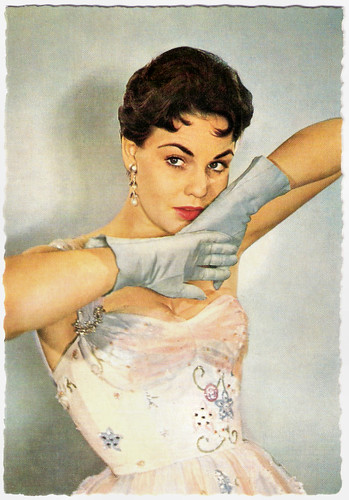
German postcard by WS-Drück, Wanne-Eickel, no. F 100. Photo: Huster.
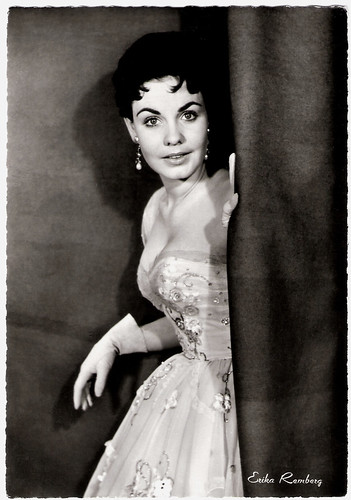
German postcard by Bartoschek-Verlag, Stuttgart-Bad Canstatt, no. 1443. Photo: Huster.
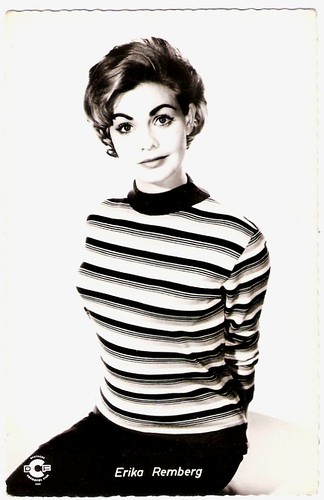
German postcard by Kolibri-Verlag G.m.b.H., Minden-Westf., no. 630. Photo: Deutsche Cosmopol. Publicity photo for the comedy Lockvogel der Nacht/Decoys of the Night (Wilm ten Haaf, 1959).
Erika Remberg was born Erika Crobath in 1932 in Medan, on the island of Sumatra in the Dutch Indies (now Indonesia). She was the daughter of a tobacco planter. The family returned to Austria during the Second World War.
Erika visited a gymnasium in Innsbruck and there she had her first stage experiences as an amateur actress. After some acting classes and small engagements she worked for the Exl-Bühne in Innsbruck.
There she met Austrian actor Walter Reyer and they married in 1950. That same year their daughter Veronika was born.
In 1950 she also made her film debut in the drama Der Geigenmacher von Mittenwald/The violin maker from Mittenwald (Rudolf Schündler, 1950) with Paul Richter.
Small roles followed in films like the comedy Drei Kavaliere/Three Cavaliers (Joe Stöckel, 1951) and the circus film Salto Mortale (Viktor Tourjansky, 1953), starring Margot Hielscher and Philip Dorn.
As the leading lady, she first appeared in the title role of the Turkish production Nilgün (Münir Hayri Egeli, 1954).
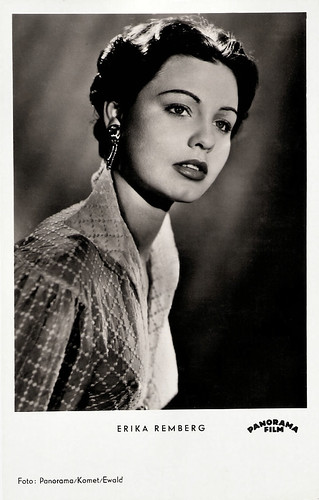
German postcard by Kunst und Bild, Berlin, no. A 778. Photo: Panorama / Komet / Ewald. Publicity still for Salto Mortale (Viktor Tourjansky, 1953).
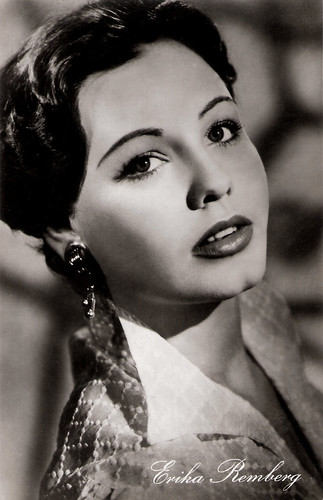
East-German postcard by VEB Progress Film-Vertrieb, Berlin, no. 444, 1957. Photo: Komet-Film. Publicity still for Salto Mortale (Viktor Tourjansky, 1953).
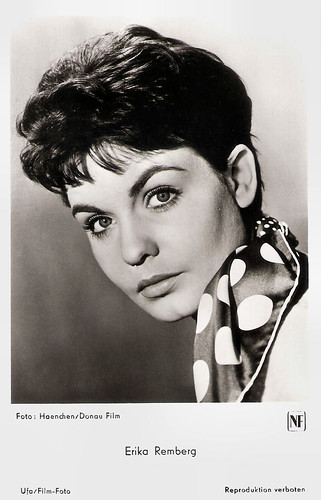
German postcard by Ufa, Berlin-Tempelhof, no. FK 3123. Photo: Haenchen / Donau Film. Publicity still for Rosmarie kommt aus Wildwest/Rosmarie comes from Wild West (Wolfgang Becker, 1956).
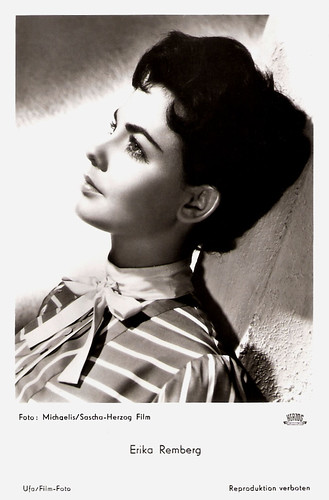
German postcard by Ufa, Berlin-Tempelhof, no. FK 3342. Photo: Michaelis / Sascha/ Herzog Film. Publicity still for Kaiserjäger/Emperor hunters (Willi Forst, 1956).
After the Exl-Bühne stopped, Erika Remberg focused completely on the cinema. She became the life partner of the German film actor Klaus Kinski in 1955 and soon she became a star of the German cinema of the late 1950s.
She was the leading lady in such films as the Western comedy Rosmarie kommt aus Wildwest/Rosmarie Comes From the Wild West (Wolfgang Becker, 1956), and three Austrian romantic comedies with Adrian Hoven: Kaiserjäger (Willi Forst, 1956), Wien Du Stadt meiner Träume/Vienna, City of My Dreams (Willi Forst, 1957) and Die unentschuldigte Stunde/The Unexcused Hour (Willi Forst, 1957).
Most of these films were not very interesting artistically, but commercially they were successes. Her biggest hit was the Swedish-German co-production Laila/Make Way for Lila (Rolf Husberg, 1958).
It was the third film version of the tale of Laila, a foundling who is adopted and raised by a Lapland chieftain. Growing to maturity in the frozen Northlands, Laila enjoys an adventuresome existence. Obedient to her adoptive parents, Lila is prepared to settle down and marry the man of their choice - until she falls in love with handsome Joachim Hansen.
Hal Erickson at AllMovie: “Lively ‘mountain drama’ (…) evocatively photographed by Sven Nykvist”. Nykvist was the director of photography of many Ingmar Bergman films.

German postcard by Kolibri-Verlag G.m.b.H., Minden-Westf., no. 166.
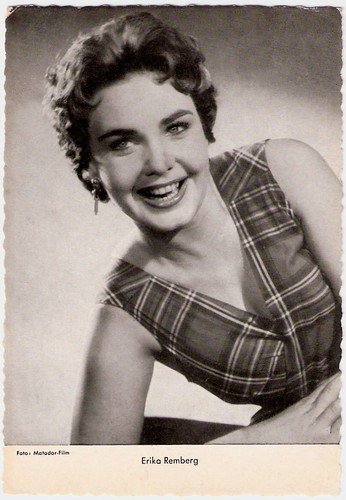
German card by WS-Druck, Wanne-Eickel, no. 143. Photo: Matador-Film.

German postcard by WS-Drück, Wanne-Eickel, no. 406. Photo: Bavaria / Filmpress Zürich.
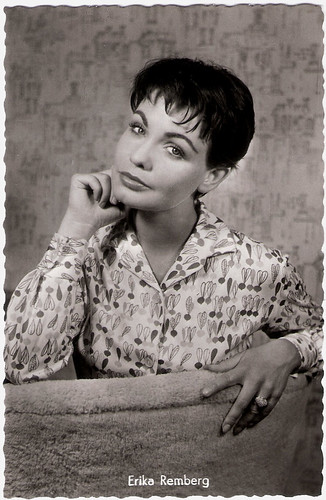
German postcard by Kolibri-Verlag G.m.b.H., Minden-Westf., no. 235. Photo: Kolibri / Enzwieser.
In the 1960s, during the decline of the German cinema, Erika Remberg worked often internationally. In 1960 she starred in the Mexican thriller Verano violento/Violent Summer (Alfonso Corona Blake, 1960) opposite Pedro Armendariz. One of her other co-stars was Gustavo Rojo, whom she later married.
That same year she also starred in the French war drama Le bois des amants/Between Love and Duty (Claude Autant-Lara, 1960) with Laurent Terzieff, and in the British horror film Circus of Horrors (Sidney Hayers, 1960).
Circus of Horrors was the third of a series of creepy films from Amalgamated Studios focusing on sadism, cruelty and violence (with sexual undertones). The film details the twisted practises of a deranged German plastic surgeon (Anton Diffring) who hides out in France after mutilating a patient and begins his work anew under an assumed name, travelling with a circus troupe. The previous films in the trilogy were Horrors of the Black Museum and Peeping Tom, both in 1959.
During the 1960s, Erika Remberg mainly appeared on TV. In the cinema she played supporting parts in mediocre fare like the vampire film Der Fluch der grünen Augen/Cave of the Living Dead (Ákos Ráthonyi, 1964) with Adrian Hoven, and the drama À belles dents/Living it Up (Pierre Gaspard-Huit, 1966) starring Mireille Darc.
Her last film was the arty but interesting erotic film The Lickerish Quartet (Radley Metzger, 1970) with Frank Wolff. The reviewer at IMDb writes: “The narrative is interesting and full of tricks. It uses flashbacks, pseudo flashbacks and multiple perspectives. Yes, it's a bit pretentious, but the plot keeps you watching.”
In the USA, The Lickerish Quartet received critical praise upon its release by many critics, including Andy Warhol and Vincent Canby as being one of the first films with graphic sex to have Hollywood-like production values.
In later years, Erika Remberg mainly worked for TV in series like Wie würden Sie entscheiden?/How Would You Decide? (Clemens Keiffenheim, Renate Vacano, 1974) and Les grands détectives/The Great Detectives (Jean Herman, 1975).
Somewhere in the mid-1970s, she said the cinema and the stage farewell. In 1981 she wrote the novel Steckbriefe/Profiles, that was adapted into a TV series.
After this Erika Remberg retired completely and married film director Sidney Hayers, with whom she had made Circus of Horrors in 1960. They lived together in Altea, Spain, where Hayers died of cancer in 2000.

German postcard by Kolibri-Verlag G.m.b.H., Minden-Westf., no. 901. Photo: Deutsche Cosmopol. Publicity photo for the comedy Lockvogel der Nacht/Decoys of the Night (Wilm ten Haaf, 1959).
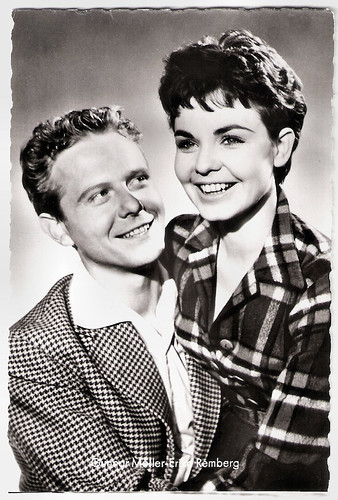
German postcard by Kolibri-Verlag G.m.b.H., Minden-Westf., no. 2838. Photo: publicity still for Drei weiße Birken/Three white birches (Hans Albin, 1961).
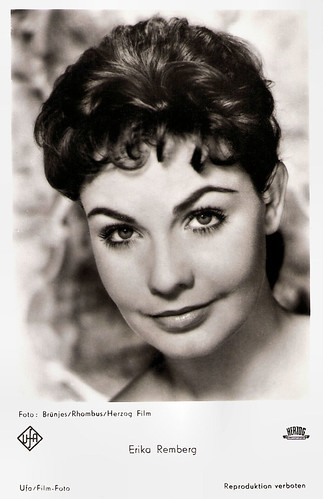
German postcard by Ufa, Berlin-Tempelhof, no. FK 3821. Photo: Brünjes / Rhombus / Ufa.
German Trailer of Laila/Make Way for Lila (1958). Source: Pidax (YouTube).
Trailer of Circus of Horrors (1960). Source: WickedVisionMagazin
(YouTube).
Trailer of The Lickerish Quartet (1970). Source: CultEpicsDVD (YouTube).
Sources: Hal Erickson (AllMovie), AllMovie, Wikipedia (German) and IMDb.

German postcard by Ufa, Berlin-Tempelhof, no. FK 4340. Photo: Sandrew / Rhombus / Ufa. Publicity still for Laila/Make Way for Lila (Rolf Husberg, 1958).

German postcard by WS-Drück, Wanne-Eickel, no. F 100. Photo: Huster.

German postcard by Bartoschek-Verlag, Stuttgart-Bad Canstatt, no. 1443. Photo: Huster.

German postcard by Kolibri-Verlag G.m.b.H., Minden-Westf., no. 630. Photo: Deutsche Cosmopol. Publicity photo for the comedy Lockvogel der Nacht/Decoys of the Night (Wilm ten Haaf, 1959).
Turkish Production
Erika Remberg was born Erika Crobath in 1932 in Medan, on the island of Sumatra in the Dutch Indies (now Indonesia). She was the daughter of a tobacco planter. The family returned to Austria during the Second World War.
Erika visited a gymnasium in Innsbruck and there she had her first stage experiences as an amateur actress. After some acting classes and small engagements she worked for the Exl-Bühne in Innsbruck.
There she met Austrian actor Walter Reyer and they married in 1950. That same year their daughter Veronika was born.
In 1950 she also made her film debut in the drama Der Geigenmacher von Mittenwald/The violin maker from Mittenwald (Rudolf Schündler, 1950) with Paul Richter.
Small roles followed in films like the comedy Drei Kavaliere/Three Cavaliers (Joe Stöckel, 1951) and the circus film Salto Mortale (Viktor Tourjansky, 1953), starring Margot Hielscher and Philip Dorn.
As the leading lady, she first appeared in the title role of the Turkish production Nilgün (Münir Hayri Egeli, 1954).

German postcard by Kunst und Bild, Berlin, no. A 778. Photo: Panorama / Komet / Ewald. Publicity still for Salto Mortale (Viktor Tourjansky, 1953).

East-German postcard by VEB Progress Film-Vertrieb, Berlin, no. 444, 1957. Photo: Komet-Film. Publicity still for Salto Mortale (Viktor Tourjansky, 1953).

German postcard by Ufa, Berlin-Tempelhof, no. FK 3123. Photo: Haenchen / Donau Film. Publicity still for Rosmarie kommt aus Wildwest/Rosmarie comes from Wild West (Wolfgang Becker, 1956).

German postcard by Ufa, Berlin-Tempelhof, no. FK 3342. Photo: Michaelis / Sascha/ Herzog Film. Publicity still for Kaiserjäger/Emperor hunters (Willi Forst, 1956).
Laila
After the Exl-Bühne stopped, Erika Remberg focused completely on the cinema. She became the life partner of the German film actor Klaus Kinski in 1955 and soon she became a star of the German cinema of the late 1950s.
She was the leading lady in such films as the Western comedy Rosmarie kommt aus Wildwest/Rosmarie Comes From the Wild West (Wolfgang Becker, 1956), and three Austrian romantic comedies with Adrian Hoven: Kaiserjäger (Willi Forst, 1956), Wien Du Stadt meiner Träume/Vienna, City of My Dreams (Willi Forst, 1957) and Die unentschuldigte Stunde/The Unexcused Hour (Willi Forst, 1957).
Most of these films were not very interesting artistically, but commercially they were successes. Her biggest hit was the Swedish-German co-production Laila/Make Way for Lila (Rolf Husberg, 1958).
It was the third film version of the tale of Laila, a foundling who is adopted and raised by a Lapland chieftain. Growing to maturity in the frozen Northlands, Laila enjoys an adventuresome existence. Obedient to her adoptive parents, Lila is prepared to settle down and marry the man of their choice - until she falls in love with handsome Joachim Hansen.
Hal Erickson at AllMovie: “Lively ‘mountain drama’ (…) evocatively photographed by Sven Nykvist”. Nykvist was the director of photography of many Ingmar Bergman films.

German postcard by Kolibri-Verlag G.m.b.H., Minden-Westf., no. 166.

German card by WS-Druck, Wanne-Eickel, no. 143. Photo: Matador-Film.

German postcard by WS-Drück, Wanne-Eickel, no. 406. Photo: Bavaria / Filmpress Zürich.

German postcard by Kolibri-Verlag G.m.b.H., Minden-Westf., no. 235. Photo: Kolibri / Enzwieser.
Circus of Horrors
In the 1960s, during the decline of the German cinema, Erika Remberg worked often internationally. In 1960 she starred in the Mexican thriller Verano violento/Violent Summer (Alfonso Corona Blake, 1960) opposite Pedro Armendariz. One of her other co-stars was Gustavo Rojo, whom she later married.
That same year she also starred in the French war drama Le bois des amants/Between Love and Duty (Claude Autant-Lara, 1960) with Laurent Terzieff, and in the British horror film Circus of Horrors (Sidney Hayers, 1960).
Circus of Horrors was the third of a series of creepy films from Amalgamated Studios focusing on sadism, cruelty and violence (with sexual undertones). The film details the twisted practises of a deranged German plastic surgeon (Anton Diffring) who hides out in France after mutilating a patient and begins his work anew under an assumed name, travelling with a circus troupe. The previous films in the trilogy were Horrors of the Black Museum and Peeping Tom, both in 1959.
During the 1960s, Erika Remberg mainly appeared on TV. In the cinema she played supporting parts in mediocre fare like the vampire film Der Fluch der grünen Augen/Cave of the Living Dead (Ákos Ráthonyi, 1964) with Adrian Hoven, and the drama À belles dents/Living it Up (Pierre Gaspard-Huit, 1966) starring Mireille Darc.
Her last film was the arty but interesting erotic film The Lickerish Quartet (Radley Metzger, 1970) with Frank Wolff. The reviewer at IMDb writes: “The narrative is interesting and full of tricks. It uses flashbacks, pseudo flashbacks and multiple perspectives. Yes, it's a bit pretentious, but the plot keeps you watching.”
In the USA, The Lickerish Quartet received critical praise upon its release by many critics, including Andy Warhol and Vincent Canby as being one of the first films with graphic sex to have Hollywood-like production values.
In later years, Erika Remberg mainly worked for TV in series like Wie würden Sie entscheiden?/How Would You Decide? (Clemens Keiffenheim, Renate Vacano, 1974) and Les grands détectives/The Great Detectives (Jean Herman, 1975).
Somewhere in the mid-1970s, she said the cinema and the stage farewell. In 1981 she wrote the novel Steckbriefe/Profiles, that was adapted into a TV series.
After this Erika Remberg retired completely and married film director Sidney Hayers, with whom she had made Circus of Horrors in 1960. They lived together in Altea, Spain, where Hayers died of cancer in 2000.

German postcard by Kolibri-Verlag G.m.b.H., Minden-Westf., no. 901. Photo: Deutsche Cosmopol. Publicity photo for the comedy Lockvogel der Nacht/Decoys of the Night (Wilm ten Haaf, 1959).

German postcard by Kolibri-Verlag G.m.b.H., Minden-Westf., no. 2838. Photo: publicity still for Drei weiße Birken/Three white birches (Hans Albin, 1961).

German postcard by Ufa, Berlin-Tempelhof, no. FK 3821. Photo: Brünjes / Rhombus / Ufa.
German Trailer of Laila/Make Way for Lila (1958). Source: Pidax (YouTube).
Trailer of Circus of Horrors (1960). Source: WickedVisionMagazin
(YouTube).
Trailer of The Lickerish Quartet (1970). Source: CultEpicsDVD (YouTube).
Sources: Hal Erickson (AllMovie), AllMovie, Wikipedia (German) and IMDb.
No comments:
Post a Comment